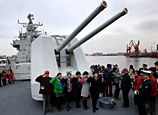
The screens also generate unwanted noise and can distract the driver, said cabby Chen Weiming.
"None of us like the advertising screens," he said.
The transport authority's order has failed to quench the anger of some people and generated concern among residents in other cities over the safety of screens in the cabs.
"Without a safety test, how could these monitors be installed in the first place and who should be blamed?" said a blogger on Sina Weibo.
The screens are also common in cabs in other cities though they are not as popular in Shanghai, where around two-thirds of its 50,000 taxis have them.
In Beijing, around 6,000 taxis, or 10 percent of the city's total, have been fitted with monitors developed by Touchmedia. In Xi'an, capital of Shaanxi province, 940 of the 987 vehicles owned by Tianzi, a major taxi operator in the city, have the screens.
Zhu Xichan, a professor at Shanghai-based Tongji University's School of Automotive Studies, called for stricter supervision of modifications to vehicles used for public transportation.
Zhu, a vehicle safety expert, said safety tests are only carried out on new vehicles before they leave the factory and modifications by users, such as installing the screens, are not included in the test catalogue.
"There's never an evaluation by the transport authority or industry supervisor on whether these modifications are safe," he said.
But he added that other safety hazards, like passengers not wearing seatbelts, are much more serious.


Latest development of H7N9 in China[Special]
















 Giant pandas safe in quake-hit zone
Giant pandas safe in quake-hit zone


![]()
